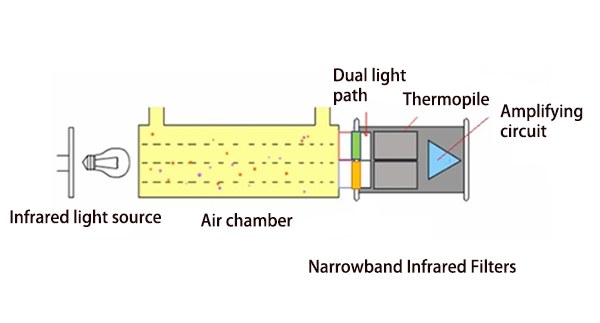How does a CO2 Sensor Work?
The proposal of the "Double Carbon Target" has brought more and more attention to the emission of carbon dioxide. Today, carbon dioxide has become an air pollutant that is mainly monitored in many fields such as industrial production, agricultural breeding, and indoor environment. With the continuous development of science and technology, the improvement of people's living standards, and people's increasing emphasis on environmental protection, quantitative monitoring, and control of carbon dioxide gas have become a growing demand in air conditioning, agriculture, medical care, automobiles, and environmental protection. Next, we will bring you knowledge about how carbon dioxide works and what kinds of it.
What is a CO2 sensor?
A carbon dioxide sensor is a kind of gas sensor specially used to detect the concentration of carbon dioxide in the air. It has the advantages of good selectivity, strong anti-interference, and high precision. It is widely used in smart homes, agriculture and animal husbandry, smart industry, automotive applications, health care, and other industries.
Working principle
Principle of Infrared Absorption
The CO2 sensor is a hand-held sensor that can detect and display the concentration of carbon dioxide in the indoor air, and can quickly and accurately detect the concentration of CO2 in the air. In addition, CO2 sensors can also be used to monitor indoor air, and can also be used to detect thermal indicators and pollutant emissions of buildings, as well as environmental monitoring.
The CO2 sensor uses the principle of optical sensing to measure the concentration of CO2 in the air. Its working principle is as follows:
First, the CO2 sensor transmits a section of red light at the detection point and then injects the red light into a filter, which can specify a certain spectrum range, so that irrelevant microwave signals can be suppressed, and only CO2 signals can be retained. Then, the CO2 sensor captures a specific spectrum signal from the red light reflected by the filter, which changes with the CO2 in the indoor air.
Send this signal to the receiver, which then feeds it back out. Carbon dioxide sensors usually measure by infrared radiation, because carbon dioxide strongly absorbs infrared rays in the 2.7, 4.35, and 14.5 bands, and considering that both the 2.7 and 14.5 absorption bands are easily affected by water vapor absorption, the 4.35 absorption band is usually selected to detect carbon dioxide.
Principle of UV Fluorescence
Another sensing technology for carbon dioxide sensors is the principle of ultraviolet fluorescence. The principle uses the fluorescence phenomenon of carbon dioxide molecules under ultraviolet excitation to measure the concentration of carbon dioxide, and the fluorescence intensity is proportional to the carbon dioxide content.
The principle of ultraviolet fluorescence has the advantages of fast response, high precision, and strong anti-interference, and is widely used in indoor air quality monitoring, bicycle driving health monitoring, and other fields.
Principle of Chemical Sensing
The principle of chemical sensing refers to the sensing technology that uses carbon dioxide molecules to react with specific chemical reagents to generate local charge changes and measure the concentration of carbon dioxide by detecting charge changes. The chemical sensing principle has high sensitivity for measuring carbon dioxide concentration and fast response speed and is widely used in the fields of air quality detection in aviation cabins and gas analysis in bioreactors.
Type of CO2 sensor
At present, there are many types of carbon dioxide sensors, including thermal conductivity, densitometer, radiation absorption, conductivity, chemical absorption, electrochemical, chromatography, mass spectrometry, infrared optical, etc. in terms of their principles.
Infrared carbon dioxide sensor
The infrared carbon dioxide sensor is based on the principle that the absorption spectrum of gas varies with different substances. The carbon dioxide sensing element controls the internal infrared lamp to emit fixed-band infrared light through the driving circuit, and the amplitude of the infrared light changes after being absorbed by the gas to be measured.
Then calculate the concentration of the gas to be measured by detecting the amount of change, that is to say, the signal output by the sensing element is filtered, amplified, converted by ADC, and input to the microprocessor. The microprocessor system performs the corresponding detection according to the collected temperature and pressure.
Compensate the temperature and pressure, and finally calculate the carbon dioxide concentration value to be measured and output it to the display device. Infrared absorption CO2 sensors have many advantages, such as high sensitivity, fast analysis speed, and good stability.
Electrochemical carbon dioxide sensor
The electrochemical carbon dioxide sensor is a type of chemical sensor that converts the concentration (or partial pressure) of carbon dioxide into an electrical signal through an electrochemical reaction. According to the detection of electrical signals, the electrochemical type is divided into potential type, current type, and capacitive type. According to the form of electrolytes, there are liquid electrolytes and solid electrolytes.
Since the 1970s, solid electrolyte carbon dioxide sensors have attracted the attention of researchers. The principle of the solid electrolyte carbon dioxide sensor is that the gas-sensitive material generates ions when passing through the gas, thereby forming an electromotive force, and measuring the electromotive force to measure the gas volume fraction.
Thermal Conductivity Carbon Dioxide Sensor
According to the principle that the total thermal conductivity of the mixed gas changes with the analysis of the gas content, the conduction carbon dioxide sensor forms two arms of the bridge by matching the detection element and the compensation element. When encountering combustible gas, the resistance of the detection element decreases. And when encountering non-combustible gas, the resistance of the detection element increases.
The bridge outputs a voltage variable that increases proportionally with increasing gas concentration. The compensation element acts as a reference and temperature compensation. Thermal conductivity carbon dioxide sensors are mainly used for natural gas, liquefied petroleum gas, coal gas and gases in civil and industrial places.

